Justine Kurland
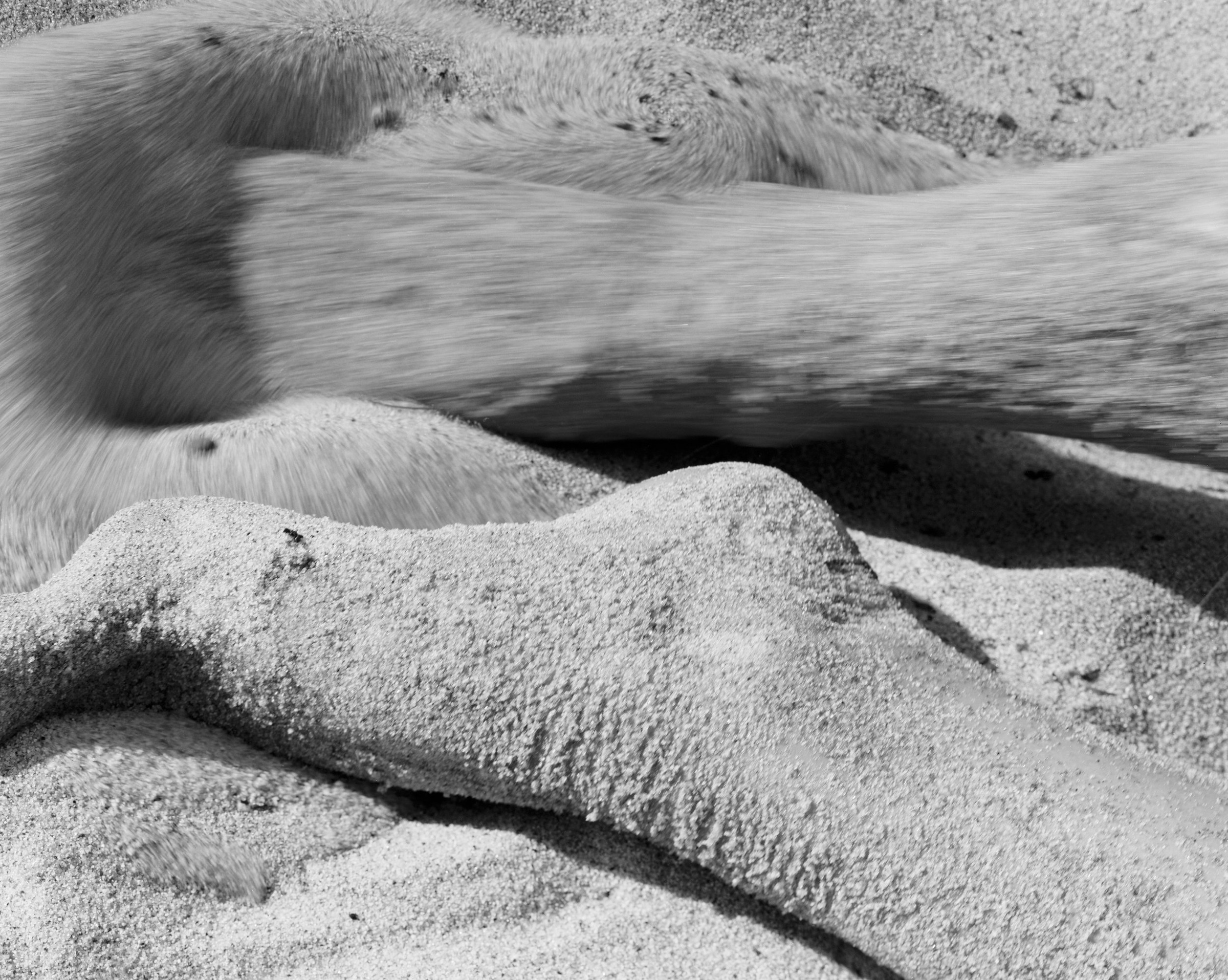
London’s Huxley Parlour Gallery Presents ‘I Belong To This’ Curated By Photographer Justine Kurland
Curated by contemporary American photographer Justine Kurland, ‘I belong to this’ gathers a group of 17 artists to explore notions of the self, family, death, and private and communal rituals, as part of a declaration of identification, a promise of solidarity, or a blurring of self into multitudes, as inspired by Ariana Reines’s poem ‘Save the World’, after which the exhibition is titled.
The work presented by the artists constantly refuse an emblematic or fixed identity, and instead, have repurposed their DNA into a limitless family album, resurrected ancestors, and activated psychic space to give shape to their experience. The photographs in the exhibition work collaboratively in resistance to destructive power dynamics by creating new pathways to knowledge in a pact between artist, subject, and viewer. It is through these acts of resistance that we are able to recognise ourselves both through and among others.
The artists include Genesis Báez, Jennifer Calivas, Naima Green, AK Jenkins, Sydney Mieko King, Keli Safia Maksud, Jacky Marshall, Qiana Mestrich, Shala Miller, Cheryl Mukherji, Diana Palermo, Calafia Sanchez- Touzé, Keisha Scarville, Wendy Small, Gwen Smith, Anne Vetter, Annie Hsiao-Ching Wang.
NR Magazine speaks with the featured artists about the inspirations behind their exhibition pieces.
Genesis Báez
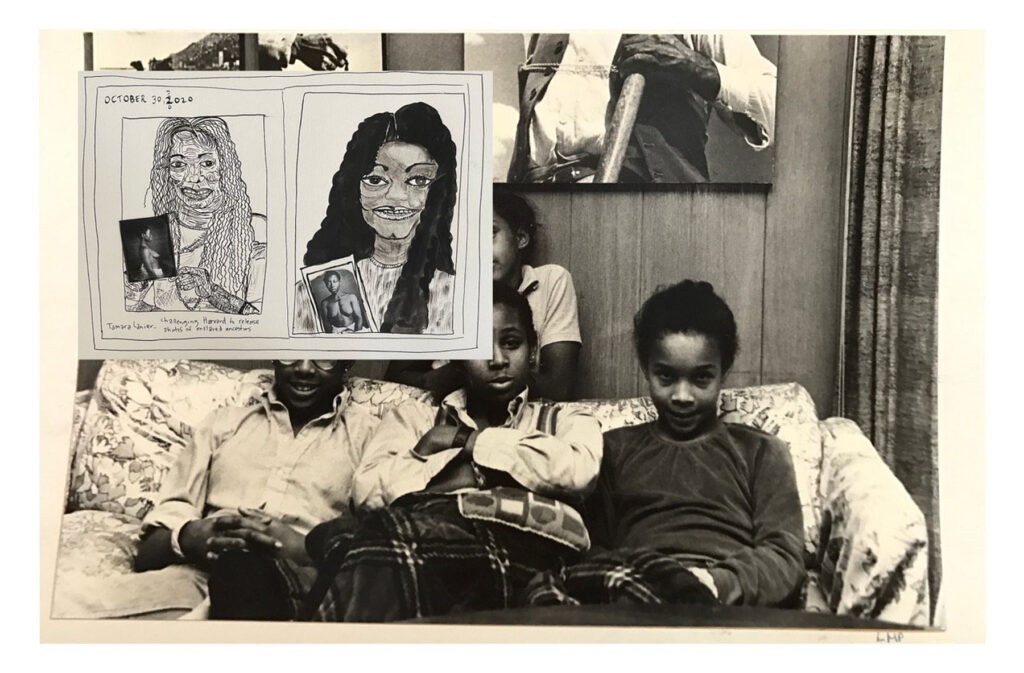
How did growing up in both Puerto Rico and Massachusetts shape you as an artist?
It shaped who I am therefore it inherently, even if indirectly, shapes my work. Having roots in two drastically different places opened my mind up at an early age. I developed a curiosity and need to see things from different perspectives.
You and your mother feature in your piece for the exhibition. Could you talk a bit about your relationship with her?
My mother and I feature in the piece Lifting Water. We lift a heavy glass vessel that is about to overflow with water. When I made this picture, I was thinking about transference, inheritance, and the weights that we collectively carry. My friend once said that she read the image as us removing the water between Massachusetts and Puerto Rico. I like this interpretation! My mother and I like making pictures together. I inherited a relationship to Puerto Rico from her, as she took me back there for the first time when I was three, and then throughout my life. But my work is not about her or our relationship. I also make photographs with many people, both family and extended community.
What do the concepts of motherhood and motherland mean to you and your work?
I don’t think about my work in relation to motherhood, but rather the idea of an origin or belonging, and how these are quite precarious and slippery. What if you don’t have a motherland – can’t go to it, can’t stay in it, or don’t want one? I don’t have a motherland. At times it’s been painful, and other times I don’t want one and it’s a relief! Sometimes, overidentifying with a ‘motherland’ can quickly slip into complicated nationalistic tendencies. I’m more interested in describing the watery, temporal experiences of existing between worlds. I used to yearn to have a clear, grounded origin that I could go to and say, ‘I belong to this.’ Now I lean into the watery places of my belonging. Belonging can be nuanced and certainly extends beyond geography.
Jennifer Calivas
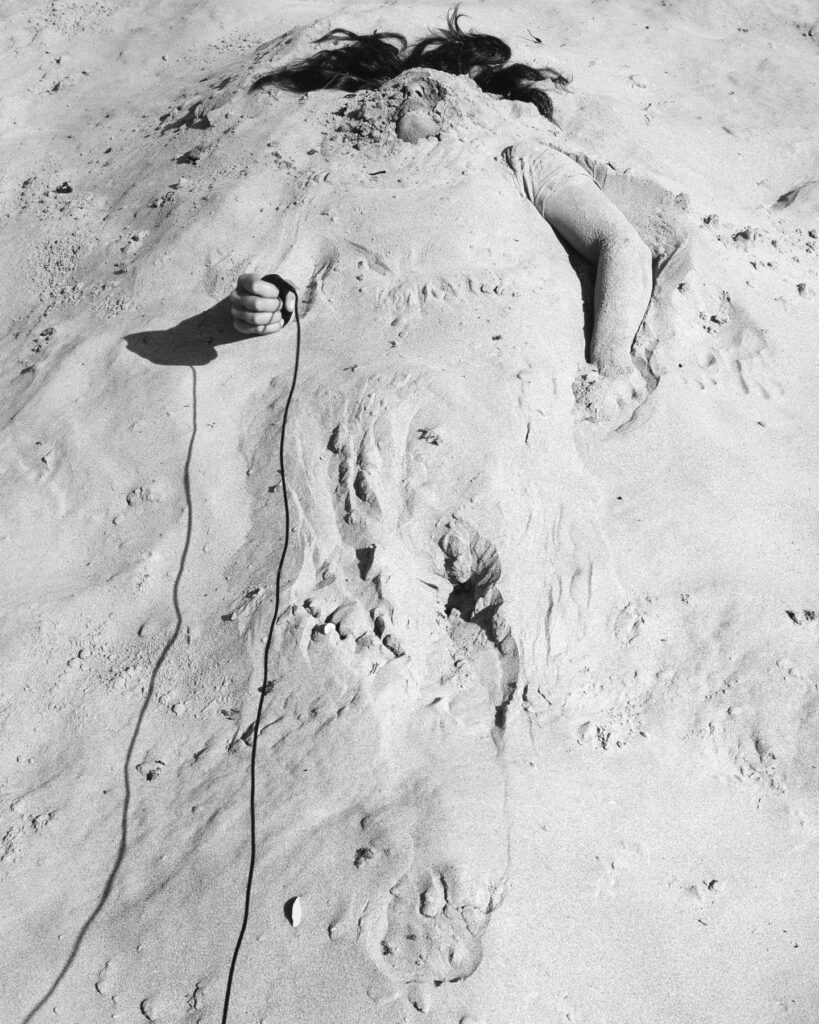
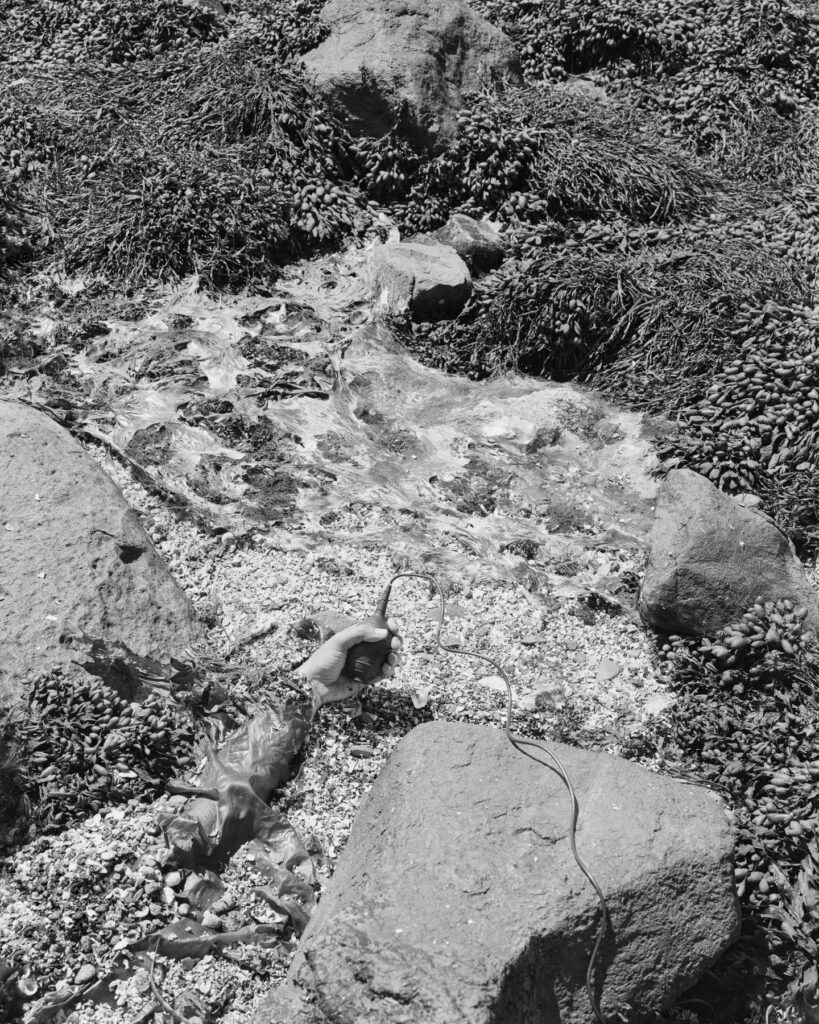
How would you describe the relationship between body, earth and identity within your practice?
It may sound corny, but sometimes I need to be close to the earth to get grounded. In graduate school I was exposed to so much in the way of art and ideas which was wonderful in many ways, but afterwards I wanted to get back to earth so much that I literally went into it. When I am underground for one of these pictures, I can’t see what things look like, so finding out how my body looks when I develop the film is really exciting. I love to see how the earth cracks and forms around me and finding out what new forms have appeared. Seeing these new sand or mud blobs take shape helps me to mess up my own sense of self and for its boundaries to feel less rigid.
What impact did performing this self-burial have on you?
It gave me a rash! All of these pictures were made by the ocean, in the sand or on mud flats. Did you know that the rotting smell of the ocean is caused by tiny microbes doing their part to digest and ferment decaying matter? When I am buried in these pictures, I can feel my body being eaten. In my effort to be still for the photograph, I end up getting consumed. The last time I made one of these images this bacteria made my skin burn and gave my assistant’s silver jewellery a patina. I think I’ve performed my last burial where I’m stuck in the sand and now. I want to move my body around which is what I’m doing in my new work.
What sculptural influences do you take from ecology and your environment?
I grew up on the coast of Maine, spending my time climbing around the shoreline, always poking and prodding at the ground to discover things. I seem to have a limitless love and fascination for this space and by burying myself in it, I get to experience it with all my senses and feel what it’s like below the surface. When I started these pictures, I had death on my mind but realised quickly that below ground is teaming with life, which has made me think about stillness differently.
Also, I am at the mercy of the weather, tides, and light when making these images. I like having to coordinate with nature in this way. There’s not much negotiation involved; I have to follow its lead. This reminds me that I am a part of environmental processes, not separate from them.
AK Jenkins
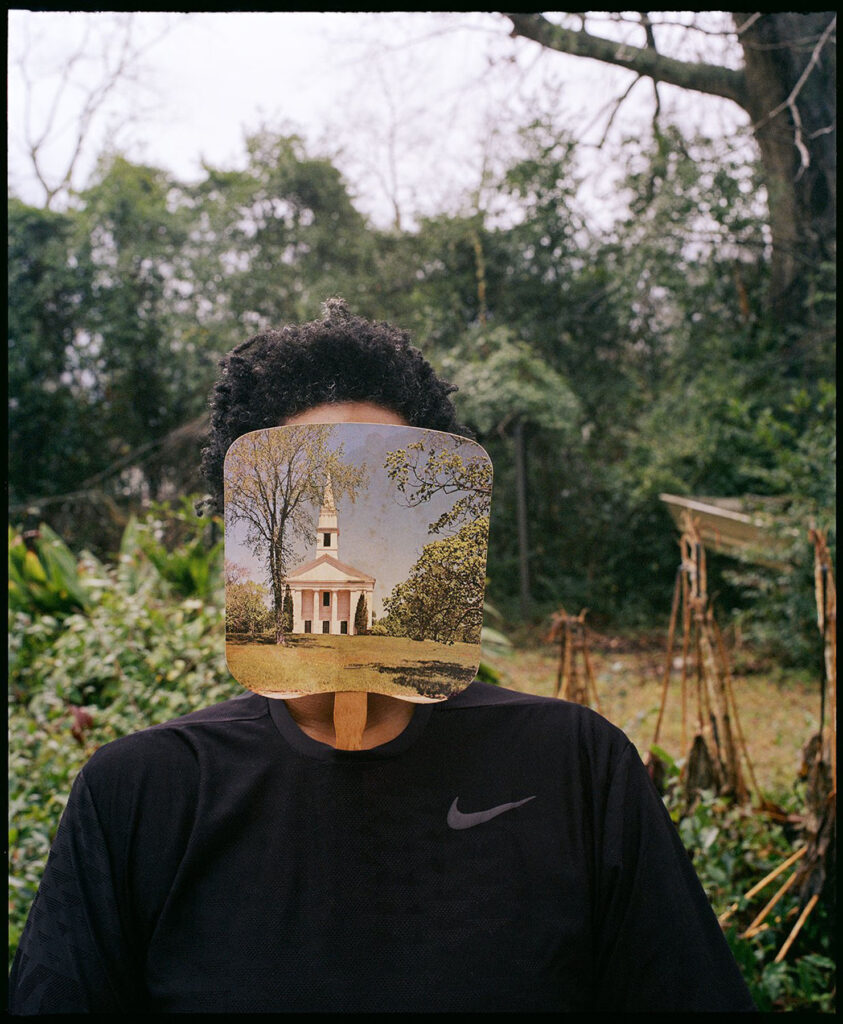
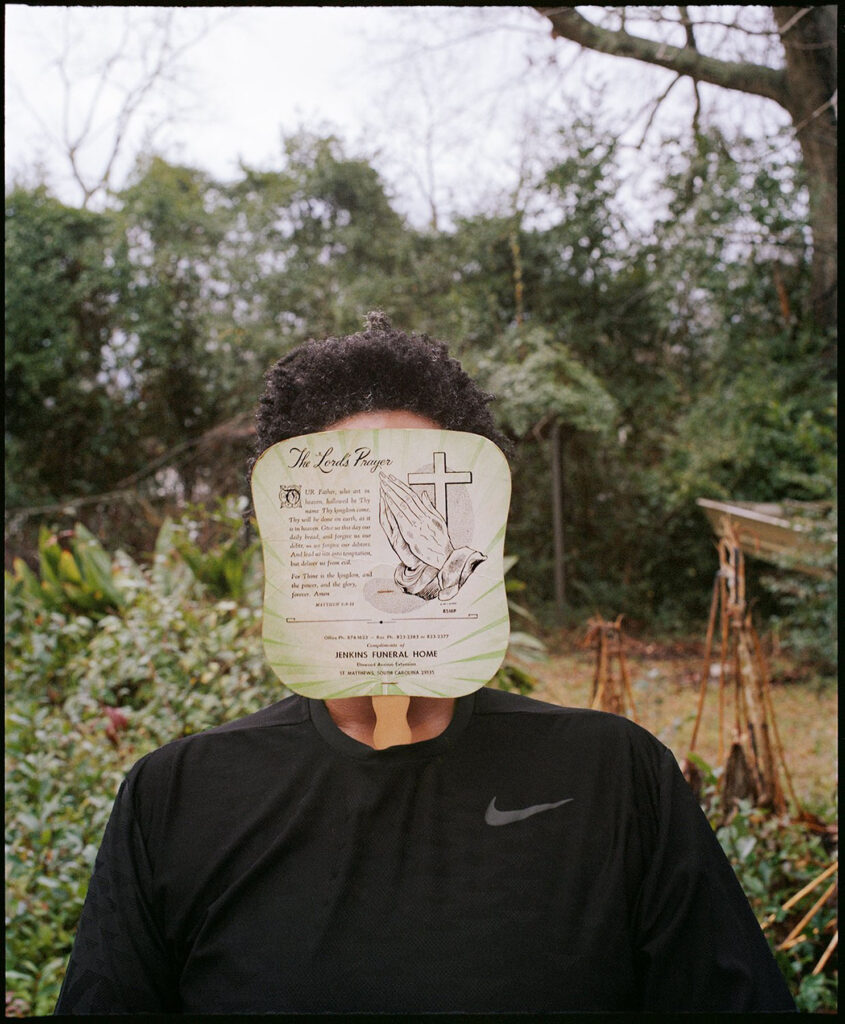
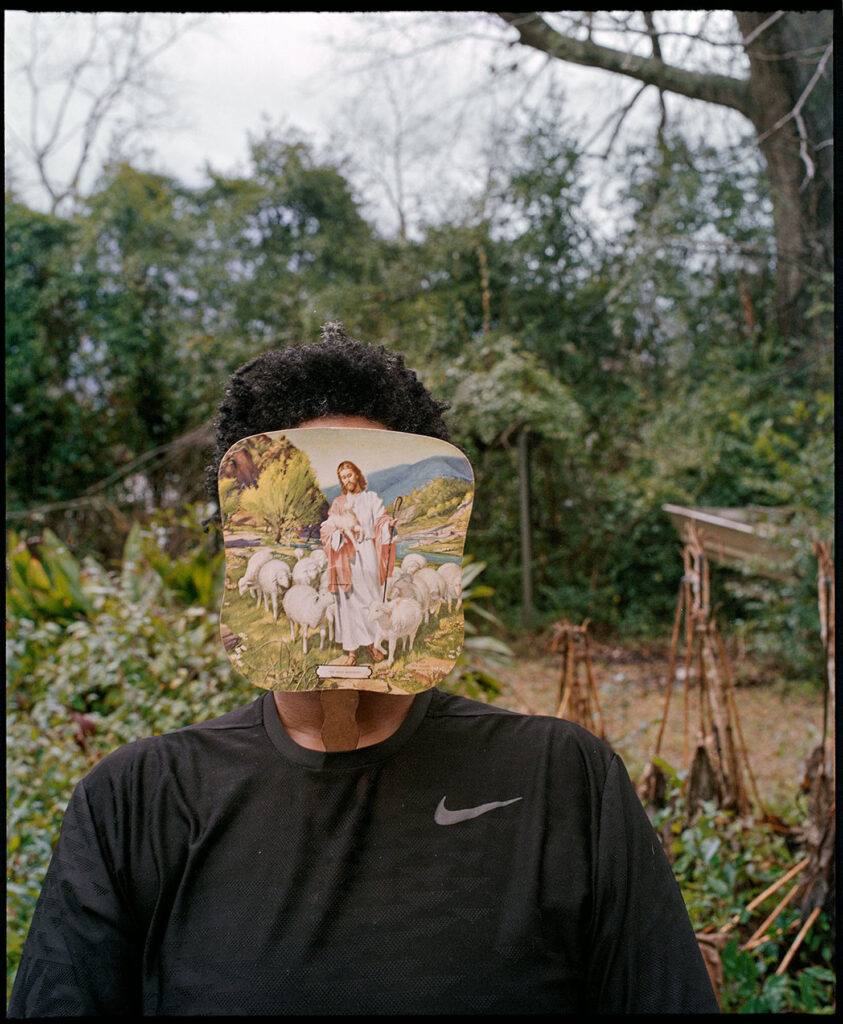
What was it like for you creating the series ‘Grandma’s Fans’?
It is very much an ancestral conversation that is happening, along with my own memories of what growing up in the church has instilled in me – how it has shaped, and at times shamed me. My grandparents’ home is still in our family and much of it remains intact. It’s really hard to create new memories in a space like that which has so many markers of presence, both physically and spiritually. It often leads me to enter into a conversation with things that may never be fully answered. It’s like how I still listen to older music and records – there is so much more I understand from them now that we both have more life in the world. The act of revisiting, be it an album or my grandmother’s house, is a practice that allows me to understand changes in meaning overtime.
What attracted you to working with portraiture?
I would say that specifically, self-portraiture is at the centre of my work right now. This shift happened after I found myself conflicted with the power dynamics and even weight of ‘shooting’ people with the camera. At the same time, we all look at the plethora of images to understand our narrative in the world. I wasn’t witnessing the nuances of my own life; it was like people like me didn’t really exist in image culture. So, imaging the complexity, strength and the love of my existence became obvious and urgent. The work is not speculative, though I’m interested in exploring that moving forward, but I’d say these thoughts, moments, and places I find myself playing with are within the context of my daily life. I appreciate that portraiture gets to the core of humanness, even though people often come to the work through identity, I think really good portraiture penetrates deeper than that. I never have to say queer and Black; you see that when I image myself. But I still do have to make images that speak to conditions of love, desire, belonging and beauty.
In writing about the series, you mention that it is ‘rapt in moments of contemplation and refusal’. How do you feel this relates to your identity as an artist?
I think it is what we try to do as artists – in making our work we are constantly wrestling with what we give, what we take or leave on the table, as we draw from our realities and imaginations.
Sydney Mieko King
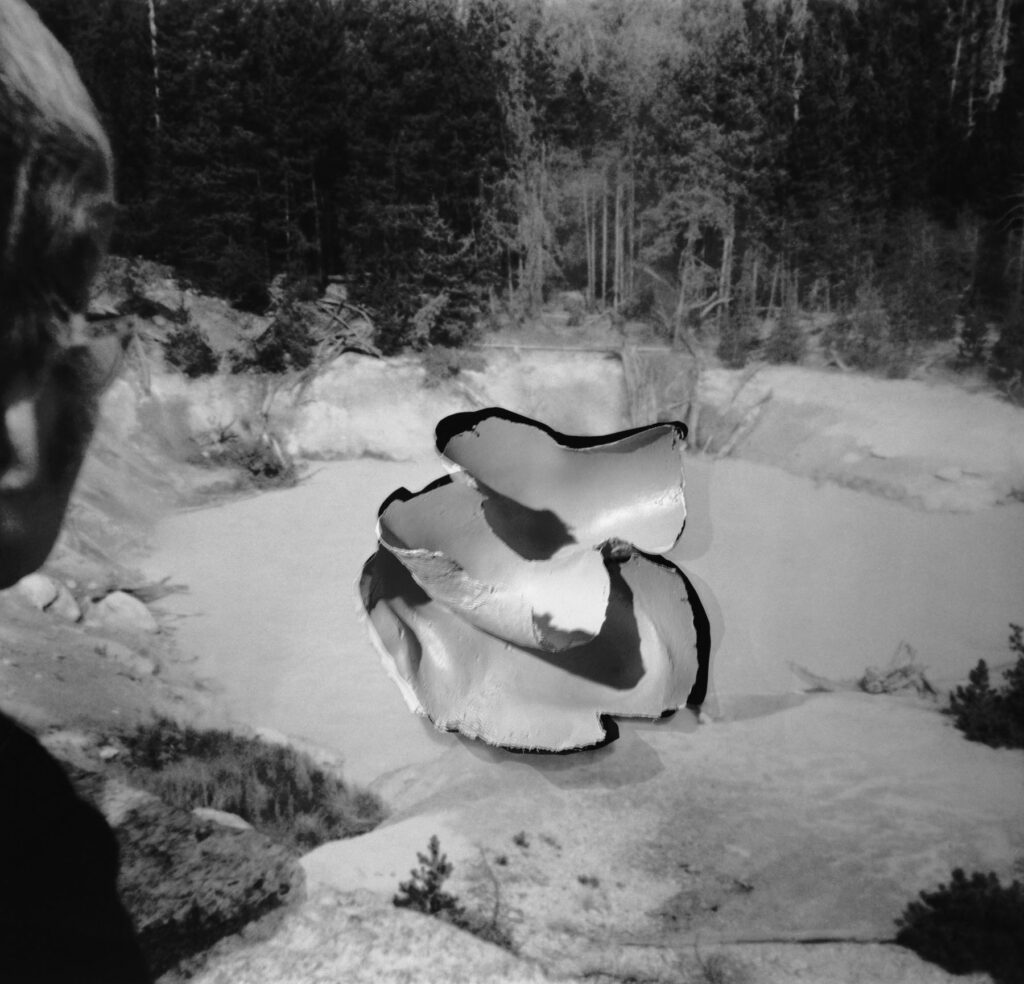
Your work in the exhibition includes archival photographs of your grandmother. Could you talk a bit about your relationship with her?
My grandma lives on San Juan Island in Washington State. My parents, brother and I visited my grandparents there every summer until around 2016. My mother always said that my interest in art came from her. We used to make chalk drawings together on the cement floor of the garage while I ate Push-Ups from the freezer. One summer I was really invested in growing plants, so we tried to plant tulip bulbs near the mailbox and cared for a tomato plant together. My grandmother lived day-to-day and told us very few stories about her past. Most of the time we would watch movies and TV together or take naps on the couch. Every summer we would get into a fight, and I would spend the rest of my visit trying to make it up to her. She was tough in a way that I couldn’t handle; she had the capacity to ignore and not forgive.
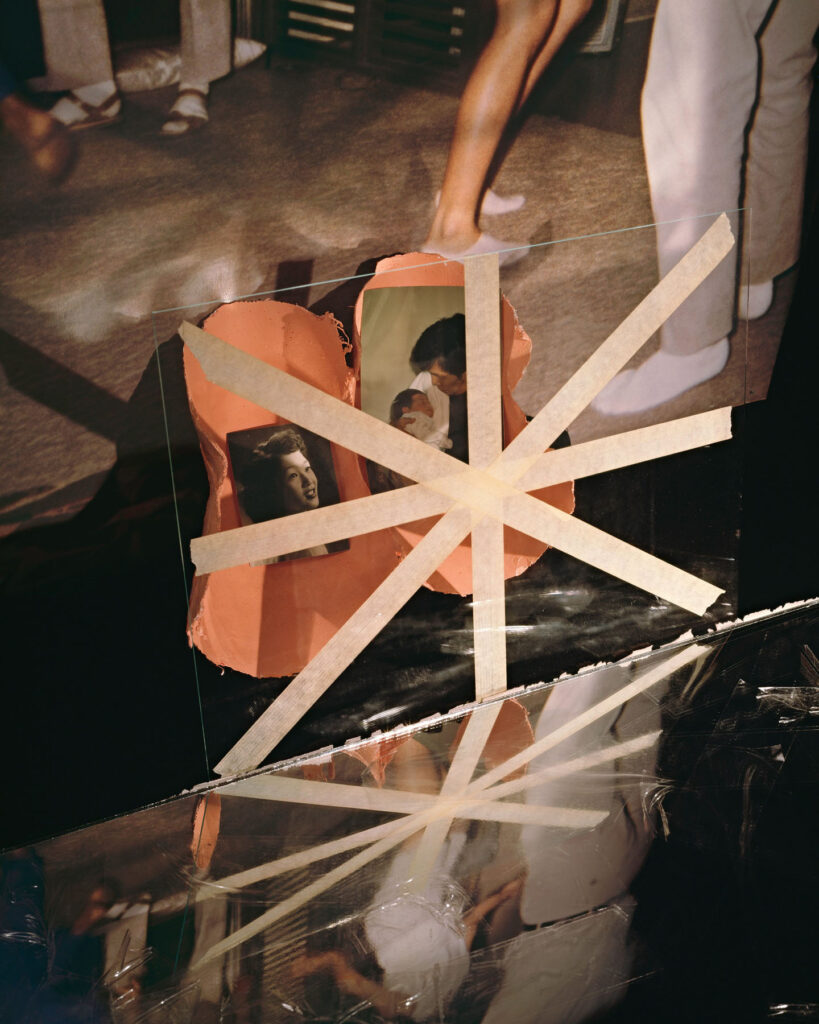
If she were my age, we would be the same size and shape. Her clothes that didn’t fit my mother I now wear. The two-piece outfits, the tie-dyed gown, the house dress that she’d put on when we drove away each summer, waving from the front steps. When I saw her this summer she faded in and out of consciousness. She still made snappy comments to me and my brother, told us we were ‘being mean to grandma’ when we joked with her at the dinner table. That was her old self, the one that loved us and pushed us away. My mother says that she is silent most days now, too tired to move.
You studied Art and Archaeology at Princeton University. Was this where you first became interested in the potential of the body to create new realities and histories?
The old photo labs at Princeton were right next to the ceramics studio, where a lot of sculpture students would make and leave behind their two-part plaster moulds. There were dozens of moulds of vases, mustard containers, wine glasses and other objects. I started photographing the objects I found there, angling the light so that the objects would appear as three-dimensional casts in my resulting images. I was fascinated by the idea that I could change my perception of objects through photography – to create an almost-tangible form when there was only the absence of one. After a while, I started making my own plaster moulds with a variety of materials, mostly to experiment with form. I would mould apples and oranges from the dining hall, blobs of foam insulation and snow procured from just outside the art building. I was fascinated by the way these objects could switch between two states, a shifting in form that I had begun to relate to my own understanding of identity and how it could be portrayed through photography.
How do you navigate the concept of identity through photography and its relationship to the body?
I view the difficulty of portraying the body through photography as a topographical one. It will always be impossible to fully translate and understand a three-dimensional body by transposing it onto a two-dimensional surface. To re-imagine the medium’s relationship to the body, I started bending my prints, later manipulating the surface of the negative to somehow empathise with or mimic the surface of what I was photographing. Thinking of the plaster mould as a form of proto-photography, I later returned to recording the surface of the body, itself.
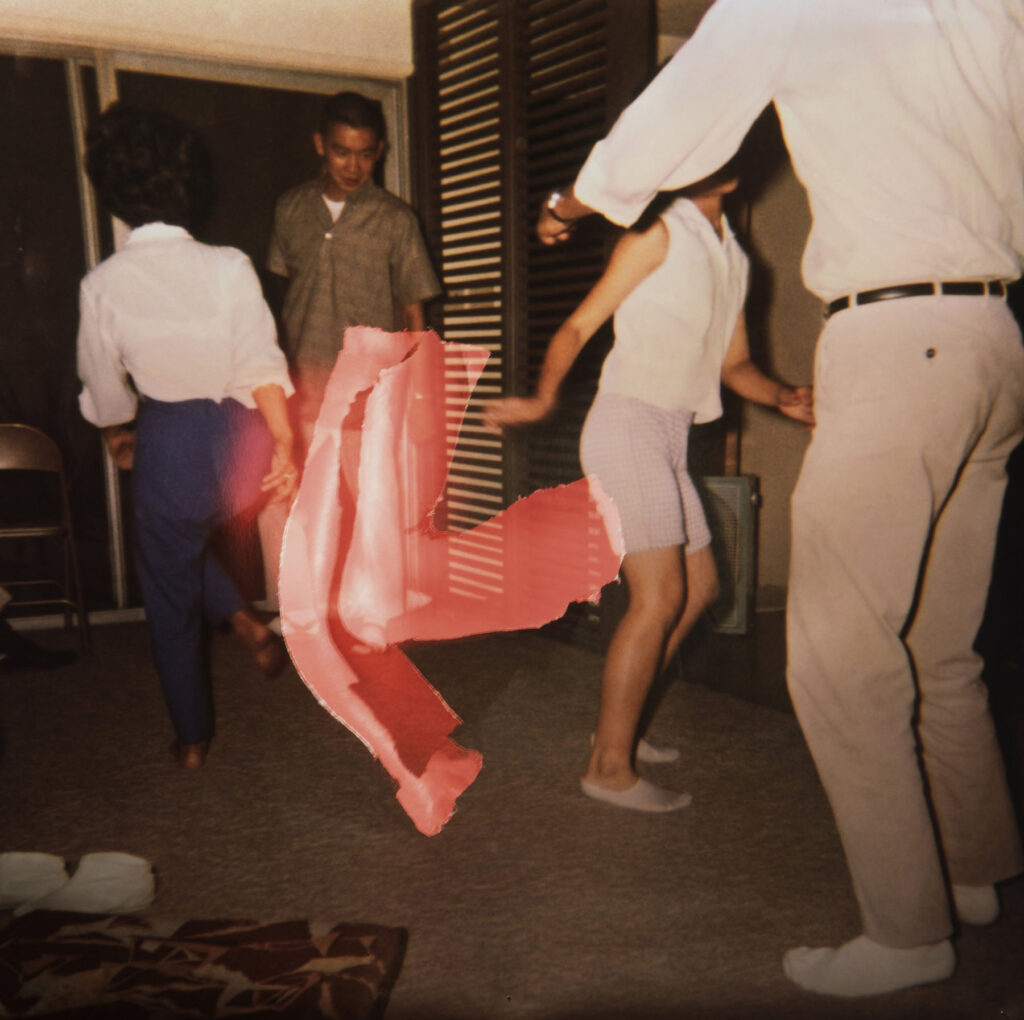
Making moulds with plaster requires so much stillness – it is a material used for replicating sculptures for educational purposes, for creating ‘death masks’ of the recently-deceased. When I mould myself in plaster, I try to occupy positions that evoke movement and breath. A bend in the stomach, legs wrapped around each other, or the overlapping parts of the body. It becomes an exercise in trying to hold still, and the inevitability of the object falling off my body with each breath I take. The moulds become an archive of my body over time – a way to understand its shifts. Some moulds that I made a year ago no longer fit; sometimes I cannot remember how I created a particular mould and go through an exercise of ‘trying on’ old positions that my body once occupied.
Keli Safia Maksud
What aspects of your work stand out to you as declarations of identification?
The overarching theme in my practice is the politics of identity. I interrogate state narratives and how they are used to manufacture national identities. It is crucial that I give a sense of my background, as it runs hand in hand with my practice. I was born in Kenya to Tanzanian parents of Muslim and Christian faith, making me a Kenyan-Tanzanian-Muslim-Christian. In addition, having only ever attended British, Canadian and American schools, I cannot deny what Frantz Fanon calls, ‘Presence Europeenne’ as a constitutive element of my identity. How does one postulate a Black and/or African self within a language or discourse in which Blackness is absent? It is a result of this fragmentation in my identity that I find an interdisciplinary approach to art making to be the most accurate and naturalist way of making sense of the world.
With the theme of this issue being Identity, I thought it would be interesting to know your thoughts on the relationship between sound and identity.
Identity is tricky, because it is often thought of as being fixed. In my work I am much less interested in fixed notions of identity and more on in-between, hyphenated, and contradictory spaces between identities. I am interested in how things bleed into each other or are in excess of boundaries that we have built around them. As such, sound allows me to explore these interests because it is omnidirectional and cannot be contained. Working from the space of leakage is generative as it is where I can begin to think about questions of connectivity and cross pollination.
Could you talk a bit about the inspirations behind your work in the exhibition?
For the past two years, I have been researching and deconstructing national anthems from various African countries. When African nations gained independence from European colonial rule, they too were motivated by the ethics of self-determination by adopting new national anthems that would speak to the new ideologies of the independent states. These anthems, however, were composed using European musical conventions (notation, language, and instruments) and many were modelled after former colonial powers, thus exposing the contradictory and hybridised nature of postcolonial subject formation where self-determination both mirrors the former colonial powers while also speaking against the former colonial power. Put differently, these new states continued to use European tools of imagining while also rejecting European ideology.
The outcome of this research has ranged from works on paper to deconstructed sound works of various national anthems. The sound piece for this exhibition is a deconstruction of the Algerian national anthem. Here, I was interested in taking an anthem that is quite revolutionary and militaristic and turning it into something that connects and allows for reflection. I am interested in how sound moves through space and how it feels in the body, so this piece begins in a very high sublime range and gradually drops to a very low piano sound which plays back from a subwoofer, which is really felt in the body and ends with this coming together of voices in some form of a chorus.
Jacky Marshall
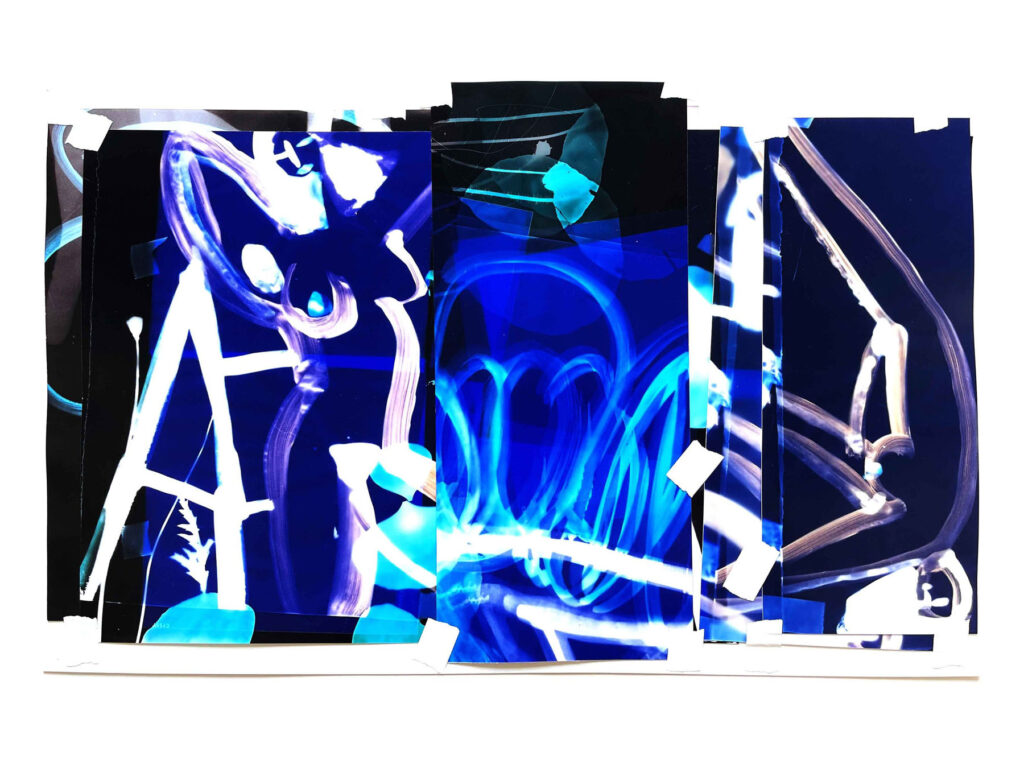
What inspired you to start working with photograms?
I have always admired Christian Schad’s Schadographs and was inspired to see what compositions I could make myself. My work is an iterative process combining all the elements of my drawing and photography, and taking my drawings into the darkroom and experimenting with new ways to make pictures was a natural process. At first it was just the poppies and ginkgo leaves, then the drawings I had been working on from Zoom life classes were added. I was drawn to the test strips which I could put together and make new collages.
What parts of your creative process help you navigate your identity?
The act of making pictures and being creative helps me express myself in ways I could not verbally articulate as a child, and probably still now as an adult. I am creating a new world for myself in my work.
What is it about blurring the boundary between painting and photography that appeals to you?
I am both a painter and a photographer. I like that I can be working on my paintings and drawings that are quick and gestural, and then take them into the darkroom and make another picture using the two processes and even adding more elements to the photograms at the same time, playing with colour through the darkroom process. Painting and drawing with light instead of paint and ink. Everything for me is available to be used and recycled.
Qiana Mestrich
Born to parents from Panama and Croatia, how do these cultures influence you and your work?
As an artist of mixed heritage, I consider my work to be transcultural in nature, meaning that it combines elements of more than one culture. I never knew my (Croatian) father, so that is a country and culture that is still very foreign to me. Eventually, I would like to use my art as a framework for discovering and connecting more to this Eastern European identity that is in my DNA.
My mother’s homeland of Panama is a very unique place geographically, it being an isthmus in Central America and the site of the canal that most people know it for. Culturally it is a mix of indigenous, European (Spanish colonial) and African influences as the country was an important centre of the trading of enslaved peoples in that region starting in the 1500s. Given this unique history, upwards of 80% of Panamanians are considered to be Black or ‘mixed race’.
Beginning in the 1830s, another wave of Black migrants came to Panama from Caribbean islands like Jamaica and Barbados – this is when my mother’s family settled in Panama. Somehow my mother’s maiden name is Scottish in origin, which we still haven’t traced back, so this cultural multiplicity is everywhere within my family tree. Genealogy is one aspect of my practice.
I’d love to know your thoughts about how you feel identity impacts knowledge sharing and community building – I know these aspects are a key part of your practice.
I first encountered photography as a teenager in the mid-1990s and I never thought twice about the fact that we studied the work of (mostly white male) artists in class. It wasn’t until I got to college where I took 3 years of colour photo and began to question, ‘where are all the Black photographers and why aren’t we studying them in class?’
My confidence as a photographer and connection to the medium was formed when I was able to discover (on my own) the works of artists like Carrie Mae Weems, Lorna Simpson, Andres Serrano and Renee Cox, among other emerging photo-based artists of that time. From there I devoured work by Latin American photographers like Garduno, Bravo, Cravo Neto, Iturbide; obsessed over Japanese photographers like Hosoe, Sugimoto, Moriyama, Miyako; marveled over Black British photographers picturing the diaspora in Europe like Shonibare, Pollard, Fani Kayode, Barnor….the list goes on.
Essentially, I was determined to educate myself about ‘photography’s other histories’ and that is how my blog, Dodge & Burn, was founded. The blog was initially a place for me to digitally hold my knowledge, but then it became a platform for the many photographer interviews I published. It connected me to a global photo community and judging by the feedback I got from my peers and email correspondence from curators, students, and educators, it was something we all needed.
Your piece in the exhibition includes your son – could you talk a bit about your relationship and the inspiration behind the work?
Winston is the oldest of my two children. He’s the son I wished for, and he was so excited to come into this world that he was born a month early. I literally went into labour during my baby shower! Parents can be biased towards their offspring of course but not a day goes by when I don’t marvel at his presence, and I am validated by the many compliments I get from other adults who know him.
The sequence of images I’m showing in the Huxley Parlour group show were taken during an impromptu dance session (which Winston often breaks into) while I was shooting some still life photos in my makeshift outdoor studio on the deck of our home. One of his favourite songs came on and he started doing this dance called the Orange Justice – his limbs were just cutting the summer air and I found it curious how his head just hung down the whole time – a position not typical when performing that dance.
The sun was blazing above us, and our home’s vinyl siding was the perfect reflector. I fired off multiple frames as I often do when photographing my children because I have to make every millisecond count before they tire of my requests to pose. I was trying to record Winston’s energy, this ecstasy he was in.
In interpreting the spirit of this work, I’m curious about the various (art) historical references that a viewer might apply to these photographs – from the religious (crucifixion) to the profane (lynching) to the technical capture of motion (Muybridge) but ultimately it reminds me of the transcendent experiences of African rituals throughout the diaspora that defy time and space.
Does motherhood influence your creative process at all?
Mothering has influenced my creative process in the sense that it made being an artist more urgent. Caring for two children fuelled my desires to care for and nurture the artist within me.
Shala Miller
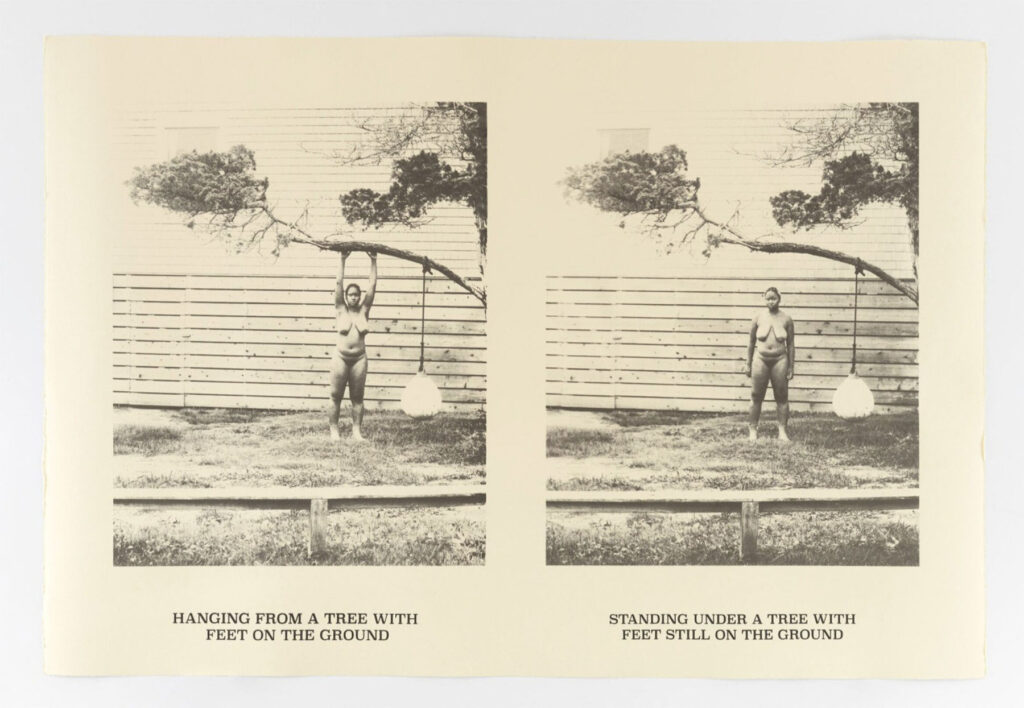
How do you feel like your pieces in the exhibition explore the concept of identity?
I believe there is much to be seen and heard within the quotidian, and there are both simple and dynamic poetics of everyday living. Poetics that continue to help me understand the beauty and pain of Black femme adulthood, which in turn helps me understand the world around me. My entire artistic practice is bred from this belief. ‘Play’ is not just an image of myself, a Black female bodied person, beneath a tree and hanging from a tree. It is an image in conversation with my history as a Black female bodied person. It is an image about resistance and finding grounding.
What inspired you to work across text and image?
Working with text and image has been a sort of touchstone of my practice over the years. It’s what led me to video installation and writing for moving image in general. I try to use text as an extension of image making, not separate from it. In ‘Play’ specifically, I was also thinking about ethnographic field work as this image is a part of an ethnographic study I’ve been doing about the epigenetics of trauma and my relationship with my mother. The text beneath the images is a kind of poetry but then also field notes.
How important is transformation to you and your practice?
What gives steam to the engine of my practice and my personhood is being devoted to discovery and being a student of life. And I think with discovery comes transformation, or a kind of repositioning. And that is the sort of thing that I strive for in both my practice and my life.
Cheryl Mukherji
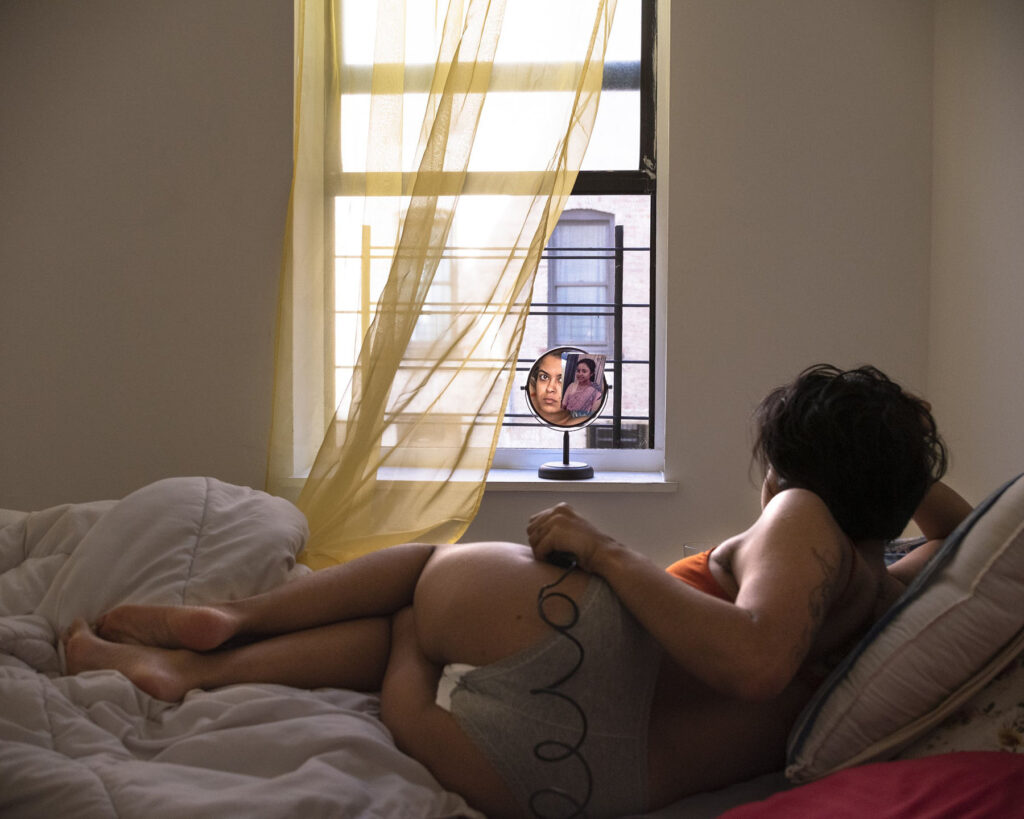
Your work for the exhibition explores transgenerational trauma through interventions in the family album. Does healing play an important part in your practice?
Healing plays as much part in my practice and life as it does with anyone. If the question leans more towards knowing if I have healed (in any way) as part of my practice, I would not have an answer to that mainly because, right now, I am interested in naming things, articulating feelings, and ideas (which is its own way of healing, I believe) more than rushing to fix them.
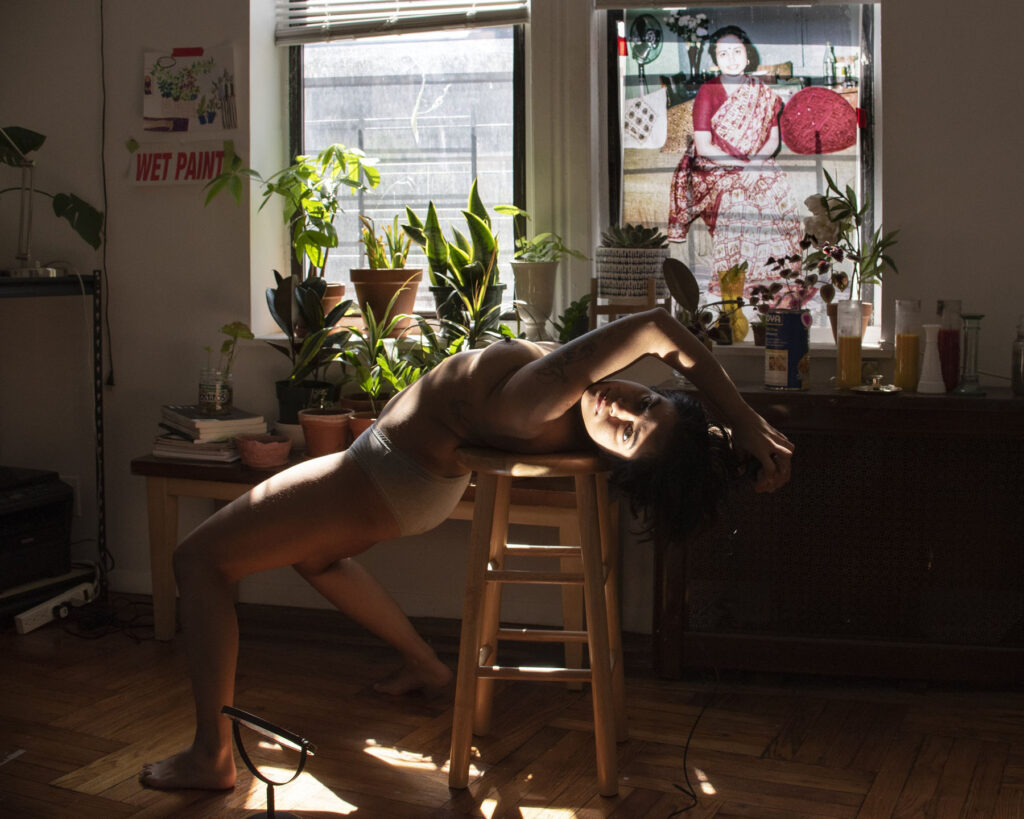
Are family and psychic inheritance important aspects of your identity as an artist?
Family, transgenerational trauma, and inheritance are recurring themes in my current work which makes them an important aspect of my identity too, because my work is semi-autobiographical. I don’t identify as an artist who is only concerned with and restricted to exploring these themes, but they do shape both me and my work in huge ways.
Diana Palermo

How does spirituality influence your identity as an artist?
Trust and faith are required for both. Being a heavily experimental process-based artist, I find that my fluidly intuitive relationship with materials and the unknown are a bridge. Personally, I will have moments where I feel like I’m conjuring a ghost while working in the darkroom, and moments when the by-products of spiritual rituals feel like sculptures. They influence and inform each other.
What was the inspiration behind the pieces chosen for the exhibition?
In the last year, I’ve thought a lot about the element of fire as an archetype in my life. I’ve been interrogating different symbolic meanings in direct and cryptic ways. I’ve been particularly curious about fire as both creator and destroyer. The poems in the two photographic prints are informed by these inquiries.
The long exposure lumen print (Incantation 11) is a diaristic document centred around the unknowns of Covid. I was quarantined out of my studio at Columbia University from March 17th until 26th August 2020. The exposure of that print measures that amount of time. I set up the conditions by writing a poem on a sheet of acetate and using it as a transparency by placing it on photo paper and leaving it on the floor for almost 6 months. I don’t think I knew how long it was going to sit alone in that room. In many ways it records my absence and created itself.
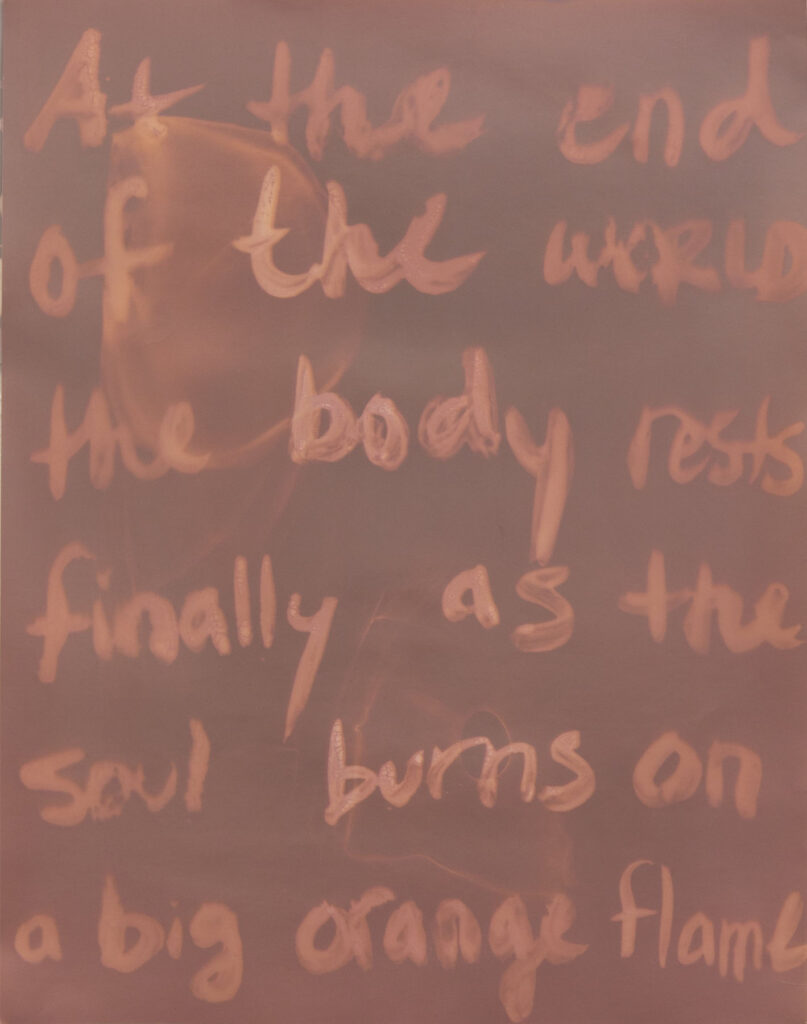
The other piece (Incantation 9) is a poem drawn with a flashlight while kneeling on the darkroom floor. The prints were then developed, and the image was revealed. For me, it speaks to the slow emergence of something new when fire and light are wielded in a balanced and intentioned manner.
Do you have any rituals as part of your creative process?
I am a pretty methodical person, but when it comes to actually creating the work, it can be somewhat chaotic. I find that my studio set-up and clean-up are extremely ritualistic. I place certain objects and materials in a way that would make me want to use them when I enter or leave. Though the parameters of the pieces are planned, the actions are frenetic and leave a lot of room for fortuity. I find this is much like the relationship one has with spiritual rituals.
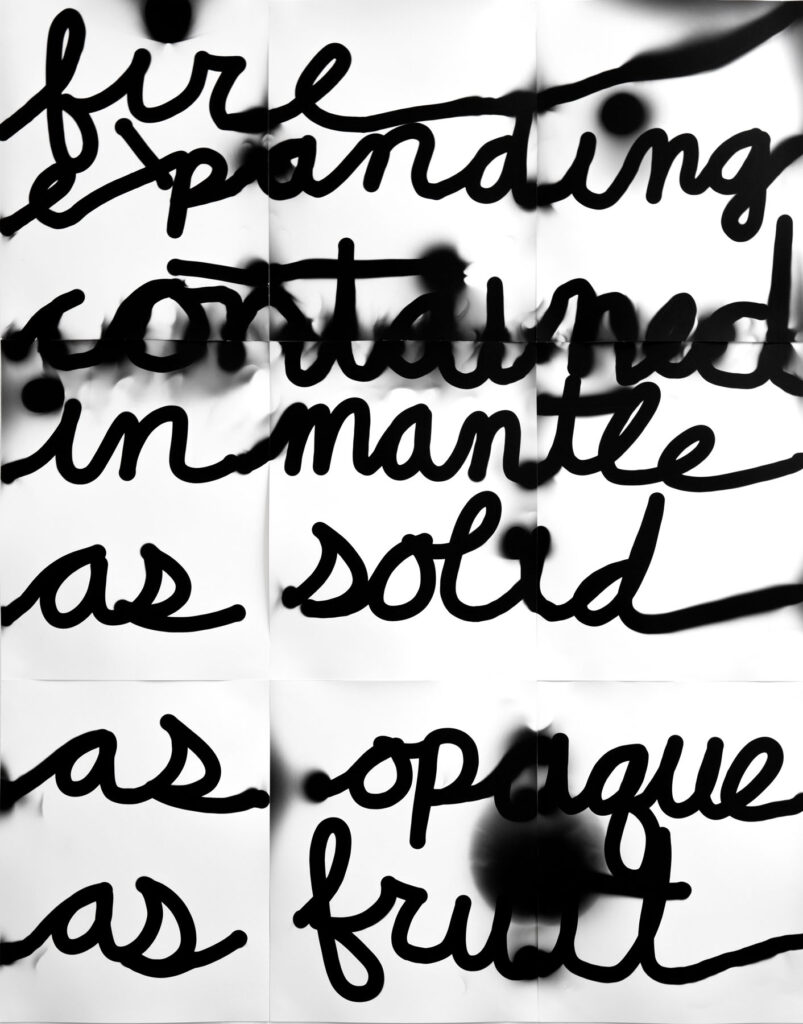
How do you see your work as a declaration of identification?
Claiming space as a queer person in otherwise confined spiritual traditions is a declaration. I’ve done a great deal of work both internally and academically unearthing the spirits and stories of queer mystics, gods, and saints. My work is a visceral reclamation of religious archetypes and stories through intuitive actions. Though many of them are created in the dark or in an absence, they are presented in the light with all their history and power like a relic in a museum or chapel.
Calafia Sanchez- Touzé
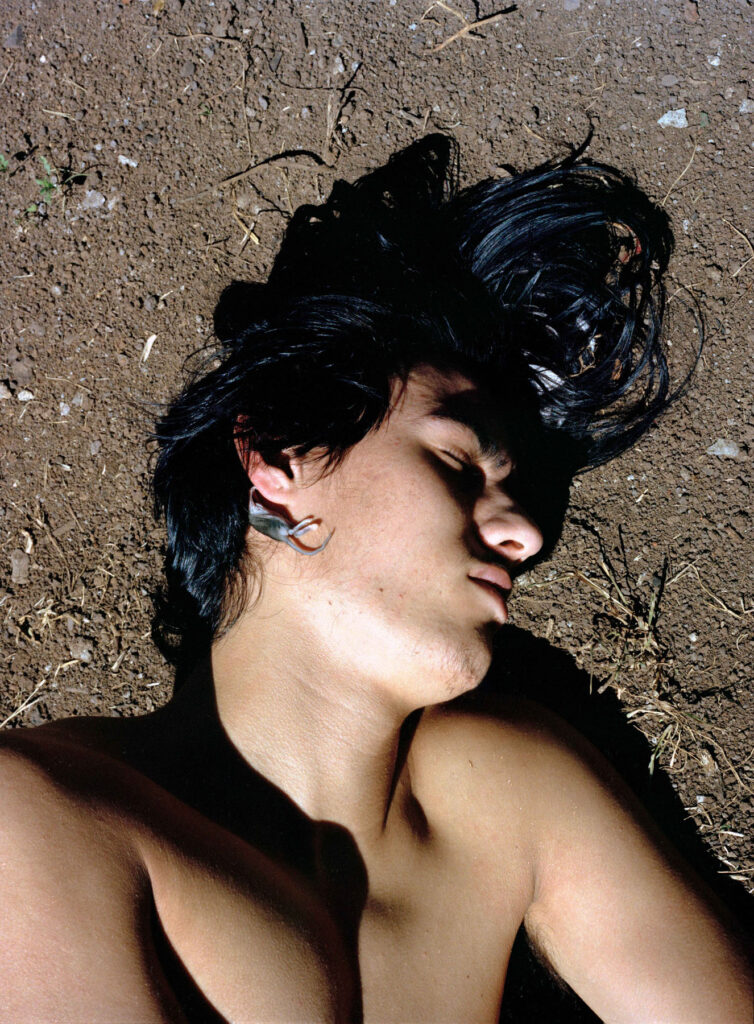
Could you talk a bit about the inspirations behind your series of images in the exhibition?
The photographs in the show are about the feeling of premature grief. A feeling I’ve long associated with my father and brother. In Mexico, I was surrounded with images of suffering, violence, and martyrdom, mostly in a religious context. I started thinking about how those images might have affected my father as a child and his understanding of his own mortality and sickness. I used crime photographs taken from the local newspaper in Michoacán as references for my portraits, as well as iconic religious postures to position my subjects.
Has exploring aspects of the body and your family always been an interest of yours?
I think my study of the body has a lot to do with my fascination with the ways skin can make us think about death. I make images where skin is plump and smooth, folding on itself, and juxtapose it with moments where skin is older and fragile, where it becomes a thin layer that could tear at any moment. Skin shows the body’s proximity to death in its capacity (or lack thereof) to seal the inside from the outside, but it can also show nothing at all.
Gwen Smith
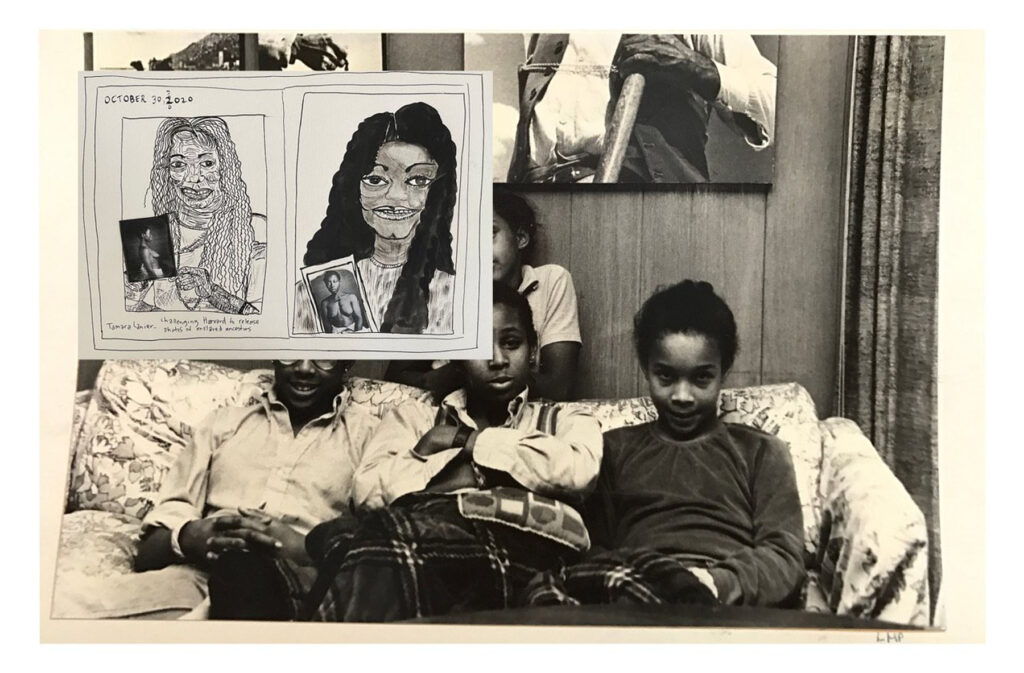
What inspires you to work between photography and painting?
I’m a vessel filled with pictures—sometimes the photographs that I generate are transformed into paintings or collages, and other times they maintain their shape as photographs. This fluidity of media bears traces of my own fugitive existence, the way that I connect my lived experience to a greater genealogy which crosses lines of colour, nationality, and family. I create proof of my own existence through my relation to others- the artwork is my evidence.
How important is archival imagery to you and your practice? Does it help ground your sense of identity at all?
Essentially, I am an archivist: I accumulate images, photographs of family and those who have made me who I am, shots of artworks that have struck me, and use them to chronicle meaning in my life. These images connect to one another, forming threads of belonging and selfhood through a labyrinth winding around the complications of dissociation and Blackness.
‘These artists mark an intractable this. The lens points, more like an ear than an index finger, in the direction of what is felt rather than seen.’ – Justine Kurland
The exhibition runs until October 16th, 2021.
Discover more here huxleyparlour.com